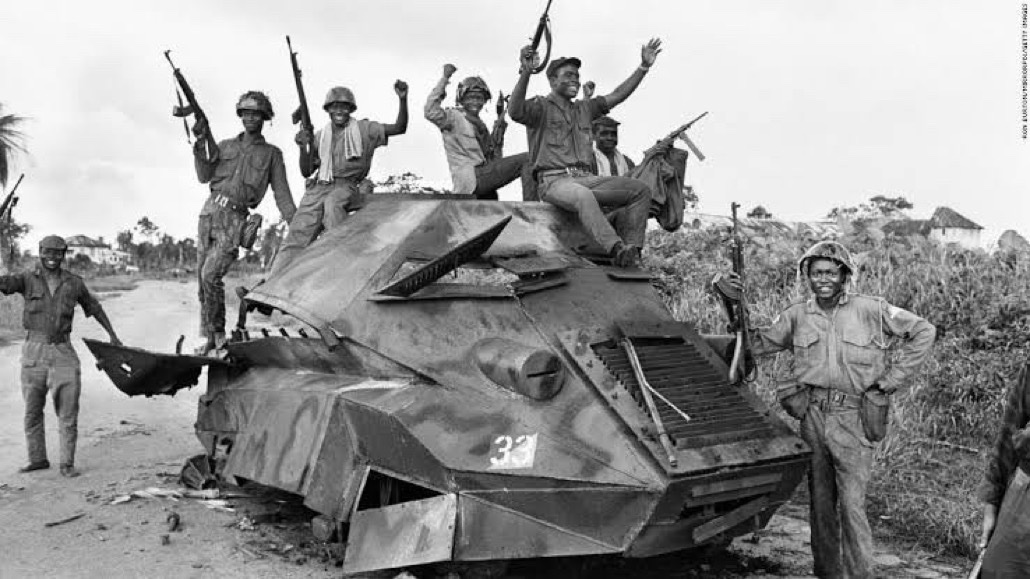The First Invasion of Onitsha (October 4 − October 12, 1967) was a large military conflict between Biafran and Nigerian forces. The Nigerian 2nd Division managed to seize control of Onitsha for less than one day before being massacred by Biafran soldiers.
HOW IT ALL STARTED:
On September 20, 1967, the Nigerian 2nd Division under General Murtala Mohammed forced all Biafran soldiers within Nigeria’s Mid-Western Region to retreat eastwards back towards Biafra.
In an attempt to halt the Nigerian advance retreating Biafran soldiers destroyed the River Niger Bridge at Onitsha, trapping the Nigerians on the other side of the river.
On October 1967 2nd Division soldiers entered Asaba and began setting up artillery positions on the banks of the Niger River while 2nd Division soldiers began preparing for an invasion.
THE BATTLE:
The Biafran 11th Division, which consisted of the 11th, 12th and 18th Battalions, was given the task of defending Onitsha. The 12th Battalion under Col. Mike Inveso was responsible for defending the area between Idah and Nsugbe, the 18th Battalion under Col. Assam Nsudoh was responsible for defending Onitsha town,& the 11th Battalion under Maj. Joseph Achuzie defended the area between Atani & Ndoni.
READ ALSO :Abagana Ambush took place during Nigeria/Biafra Civil war
The beaches around Onitsha were heavily mined and were backed up by Biafran machine guns and anti-tank weapons.
Because the Biafrans had detonated the Niger River Bridge Gen. Murtala Mohammed was left with the decision of crossing the Niger River at Idah or making and amphibious attack on Onitsha. Gen. Mohammed disregarded advice from the Nigerian Army HQ in Lagos and …
chose to attack Onitsha head on. On October 4, 1967, Gen. Mohammed ordered Nigerian artillery to begin bombarding Onitsha.
Eight days later Gen. Mohammed personally led a 10-boat armada carrying 5,000 Nigerian soldiers across the Niger River into Onitsha. The Biafran 18th Battalion resisted stubbornly but were forced to retreat in disarray.
However, according to history instead of pursuing the retreating Biafrans and occupying the town the Nigerians turned their attention to looting and burning the Onitsha Market to the ground. This gave the 18th Battalion time to reorganize and make a counter-attack.
The 11th Battalion under Maj. Achuzie made their way up the New Market road while the 18th Battalion under Col. Nsudoh swung down the Old Market road towards Onitsha. Nigerian soldiers stationed in Onitsha were totally routed and most were either killed or taken prisoner.
Undaunted, Gen. Mohammed ordered a 5,000 man reserve from Lagos to cross the Niger River into Onitsha but they were once again defeated.
Gen. Mohammed ordered troops under Lt. Col. Ipoola Alani Akinrinade to make a third assault on Onitsha but were once again thwarted by the Biafran 11th and 18th Battalions.
It was now when Gen. Mohammed realized there was no hope in attacking Onitsha from Asaba and he began the audacious task of heading towards Idah in the North.
In December 1967 the Nigerian 2nd Division under Col. Murtala Mohammed along with the Nigerian 6th Battalion under. Lt. Col. Shehu Musa Yar’Adua crossed the Niger River at Idah and made their way to Enugu.

In early January 1968 Col. Mohammed led a two pronged attack in which they encountered the Biafran 53rd Brigade under Maj. Christian Ude, who was re-enforced by mercenaries, while also attacking the Biafran 12th Battalion under Col. Mike Inveso at Atani, forcing them to retreat.
Gen. Mohammed’s war machine rolled on, smashing through Biafran made obstacles, including detonated bridges. A few weeks later the French mercenary commander of the Biafran 53rd Brigade was wounded and evacuated.
Despite heavy casualties Col. Mohammed’s troops stormed Udi followed by Ozala a few days later, cutting off the S Division from the rest of Biafra. Head of State Odumegwu Ojukwu now made Gen. Timothy Onwuatuegwu commander of the S Division.

With artillery and aerial assistance the Nigerians rolled on and managed to overrun numerous towns and cities. In the face of overwhelming pressure Biafran soldiers retreat and began to set up defensive positions.
On January 19 the Nigerian 2nd Division entered and occupied Biafran Maj. Gen. Alexander Madiebo’s hometown, Awka. With the road to Onitsha now open to the Nigerian 2nd Division, Gen. Ojukwu placed the Biafran 11th Division under the command of Maj. Joseph Achuzie.
Whenever the Nigerians attacked Maj. Achuzie would counter-attack and this strategy managed to hold off Nigerian troops 22 km outside of Onitsha. On March 20, 1968, Nigerian 2nd Division troops marched through Abagana and finally reached Onitsha.
The final battle would last less than 24 hours. Although the Nigerians were forced to pay with heavy casualties, they managed to capture Onitsha while the Biafran 11th Division retreated to Nnewi.
Credit : @Nigerianstories